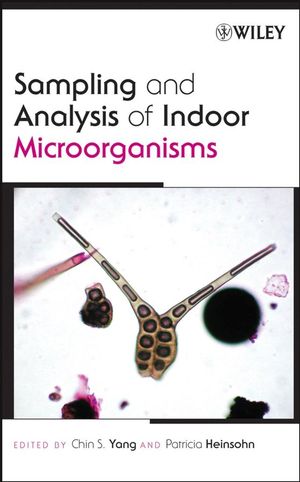Sampling and Analysis of Indoor MicroorganismsISBN: 978-0-471-73093-4
Hardcover
273 pages
March 2007
 This is a Print-on-Demand title. It will be printed specifically to fill your order. Please allow an additional 10-15 days delivery time. The book is not returnable.
|
||||||
CONTRIBUTORS.
1. INTRODUCTION TO MICROBIOLOGICAL GROWTH AND CONTAMINATION INDOORS (Chin S. Yang and Patricia A. Heinsohn).
1.1. Introduction.
1.2. Health Effects of Indoor Fungal and Bacterial Growth.
1.3. Team and Individual Expertise.
1.4. Approach of This Book.
1.5. Conclusion.
2. CONDUCTING BUILDING MOLD INVESTIGATIONS (Patricia A. Heinsohn).
2.1. Introduction.
2.2. Baseline Investigation.
2.2.1. Physical Inspection.
2.2.1.1. Visual Inspection.
2.2.1.2. Documentation.
2.2.1.3. Moisture and Moisture Mapping.
2.2.2. Sampling Design.
2.2.2.1. Air Sampling Methods.
2.2.2.2. Selection of Air Sampling Instruments.
2.2.2.3. Air Sampling Flowrate, Pump Calibration, and Sampling Duration.
2.2.2.4. Number of Indoor and Outdoor Air Samples, Air Sampling Locations, and Order of Sampling.
2.2.2.5. Sampling Techniques.
2.2.2.6. Surface Sampling Techniques and Analysis.
2.2.2.7. Laboratory Selection.
2.2.2.8. Prior Notification.
2.3. Destructive Testing Investigation.
2.4. Sampling during Mold Remediation Oversight and Clearance.
2.5. Conclusions.
3. MICROBIOLOGICAL SAMPLING STRATEGIES IN INDOOR ENVIRONMENTS (Philip R. Morey).
3.1. Introduction.
3.2. Sampling Strategy.
3.3. Spatial or Location Variables.
3.4. Temporal (Time) Variables.
3.5. Indoor/Outdoor Comparisons.
3.6. Complaint and Noncomplaint Zones.
3.7. Source and Air Samples.
3.8. Bulk Samples.
3.9. Dust Samples.
3.10. Surface Sampling.
3.11. Culture Plate Impactions and Liquid Impingers.
3.12. Spore Trap Samplers.
3.13. Sampling by Filtration.
3.14. Conclusions.
4. MICROSCOPIC ANALYTICAL METHODS FOR FUNGI (De-Wei Li, Chin S. Yang, and F. Harrington).
4.1. Introduction.
4.2. Principles and Usage of Microscopes.
4.2.1. Microscopes.
4.2.2. Microscope Objectives.
4.2.3. Photomicrographic Accessories.
4.3. Aseptic Technique and Biosafety.
4.4. Sample Preparation for Spore Count.
4.5. Materials Needed for Preparing Samples.
4.6. Staining and Mounting Techniques.
4.7. Procedures for Identification and Quantification of Spore Traps.
4.8. Techniques for Spore Count Analysis.
4.9. Background Particulates (Nonspore Miscellaneous Materials).
4.10. Limits of Detection.
4.11. Data Presentation.
4.12. Variation of Replications and Duplications.
4.13. Sample Preparation for Direct Examination or from Cultures.
4.13.1. Bulk Samples.
4.13.2. Bulk Dust Samples.
4.13.3. Swab Samples.
4.13.4. Tape Lift Samples.
4.13.5. Culture Samples.
4.14. Evaluation of Fungal Infestation.
4.15. Training of Microscopy Analysts.
4.16. Quality Assurance/Quality Control Procedures.
4.17. WEB Resources.
5. CULTURE-BASED ANALYTICAL METHODS FOR INVESTIGATION OF INDOOR FUNGI (Florence Q. Wu).
5.1. Advantages and Limitations of Culture-Based Analytical Methods.
5.2. Factors Influencing the Results of Culture-Based Analysis.
5.2.1. Ecological Considerations.
5.2.2. Viability of Fungal Spores.
5.2.3. Selection of Culture Media.
5.2.4. Concentration Variations.
5.2.5. Sampler Performance, Sampling Time, and Culture Preparation.
5.2.6. Experience of the Analyst.
5.3. Culturable Sampling Considerations.
5.3.1. Air Samples.
5.3.2. Surface Samples.
5.3.3. Bulk Samples.
5.3.4. Dust Samples.
5.4. Sample Preparation Methods.
5.5. Identification of Filamentous Fungi.
5.6. Data Reporting.
5.7. Data Interpretation.
5.8. Laboratory Quality Assurance.
6. AIRBORNE BACTERIA IN INDOOR ENVIRONMENTS (Linda D. Stetzenbach).
6.1. Introduction.
6.2. Bacterial Aerosols.
6.3. Selected Bacteria-Associated Health Effects.
6.4. Analysis of Samples for Airborne Bacteria.
6.5. Summary.
7. GENETICS-BASED ANALYTICAL METHODS FOR BACTERIA AND FUNGI IN THE INDOOR ENVIRONMENT (Richard A. Haugland and Stephen J. Vesper).
7.1. Introduction.
7.2. Genetics-Based Analytical Techniques.
7.2.1. In Vitro Nucleic Acid Amplification.
7.2.2. Hybridization Probes.
7.2.3. Nucleic Acid Sequencing.
7.2.4. Microbial Strain Typing.
7.3. Applications of Genetics-based Methods for Indoor Microbiological Analyses.
7.3.1. Detection of Pathogenic, Allergenic, and Toxigenic Bacteria and Fungi Using Nucleic Amplification and Hybridization Probe Techniques.
7.3.2. Microbial Strain Typing and Identification by Nucleic Acid Sequencing.
7.4. Quality Control/Quality Assurance and other Challenges.
7.5. Outlook for the Future.
8. WOOD IN THE BUILT ENVIRONMENT—CONDITIONS FOR MOLD AND DECAY (Susan E. Anagnost).
8.1. Introduction.
8.2. Molds and Wood Decay Fungi.
8.3. Moisture Requirements for Growth of Molds and Wood Decay Fungi.
8.4. Water and Wood—Relative Humidity versus Moisture Content.
8.4.1. Wood Moisture Content and the Fiber Saturation Point.
8.5. Moisture Requirements for Fungal Growth.
8.5.1. Moisture Requirements for Wood Decay Fungi.
8.5.2. Moisture Requirements for Mold Fungi.
8.6. The Effect of Changing Moisture and Temperature Conditions.
8.7. Susceptibility of Building Materials to Mold.
8.7.1. Visible versus Concealed Mold.
8.8. The Effects of Building Design and Construction.
8.9. Techniques for Assessment of Wood Decay and Mold in Buildings.
8.9.1. Nondestructive Testing.
8.9.2. Destructive Testing.
8.10. Summary.
9. USE OF STATISTICAL TOOLS FOR DATA PRESENTATION AND ANALYSIS OF INDOOR MICROORGANISMS (Stella M. Tsai).
9.1 Introduction.
9.2 Descriptive Analysis.
9.3 Correlation.
9.4 t-test and Nonparametric Methods.
9.4.1. Using t-test to Test Differences between Two Means (Two Groups of Samples).
9.4.2. Nonparametric Test for Two Groups of Samples.
9.5 Analysis of Variance (ANOVA) and Chi-Square Statistics.
9.6 Discussion.
10. ECOLOGY OF FUNGI IN THE INDOOR ENVIRONMENT (Chin S. Yang and De-Wei Li).
10.1. Introduction.
10.2. Factors Affecting Fungal Growth Indoors.
10.2.1. Biotic Factors.
10.2.2. Abiotic Factors.
10.2.3. Interactions Between Temperature, Moisture, and Fungi Indoors.
10.3. Ecological Interactions Between Fungi and Environmental Factors.
10.3.1. Indoor Fungal Ecology.
10.3.2. Specific Ecological Niche of Some Common Indoor Fungi.
10.4. Release and Dispersal of Fungal Spores.
10.4.1. Fungal Spore Types and Their Release.
10.4.2. Fungal Spore Dispersal.
10.5. Conclusions.
11. A RETROSPECTIVE AND FORENSIC APPROACH TO ASSESSMENT OF FUNGAL GROWTH IN THE INDOOR ENVIRONMENT (Chin S. Yang).
11.1. Introduction.
11.2. Microbial Forensics.
11.3. Rationales and Mycological Backgrounds.
11.4. Other Signs and Information.
11.5. Case Studies.
11.6. Conclusions.
12. MICROBIAL REMEDIATION IN NONINDUSTRIAL INDOOR ENVIRONMENTS (Philip R. Morey).
12.1. Introduction.
12.2. Mold Remediation Principles.
12.3. Mold Removal Methods.
12.4. Dust Control during Mold Remediation.
12.5. Air Sampling for Molds.
12.6. Clearance by Measurement of Residual Dust.
12.7. HVAC System Mold Remediation.
12.8. Remediation of Room Contents in Moldy Buildings.
12.9. Quality Assurance during Mold Remediation.
12.10. Microbial Remediation of Legionellas and Biofilms.
12.11. Remediation of Sewage Contamination.
APPENDIX COMMON AIRBORNE AND INDOOR FUNGI AND THEIR SPORES (De-Wei Li).
INDEX.



